INSIDE
RACING
T E C H N O L O G Y
D Sports p. 1
D Sports p. 1
D Sports p. 2
IRT Home
News Page
Contents Page
Newsletter &
Books
email Paul
Engineering in Club Racing, page 3
Ted's High-Tech Toys
Ted James retired from United Airlines as an avionics maintenance
controller, and Nancy still works for United as a flight attendant.
She schedules her flights around their racing plans. Their children
are grown and have flown the nest. They have three grandchildren.
Ted started the DSR with a locally-produced AMAC mild-steel chassis
and modifies it as needed. The body work started out as a March
Sports 2000. "I do the fiberglass work," Nancy said.
"When we started out Ted told me, 'I don't do fiberglass.
If you break it you have to fix it yourself.' "
Ted fabricates most of the mechanical components himself including the suspension links. The front suspension features wide-based upper and lower A-arms and a tubular anti-roll bar with slide adjustment. Front and rear uprights are the same commercially-available parts as on Lutrell Harms' car. The rear suspension is also conventional with trailing arms, lateral links, and a tubular anti-roll bar.
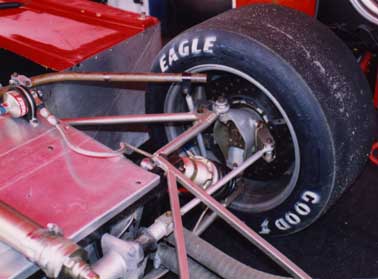
The brake system is also similar to that on Lutrell's car.
Ted machined his own aluminum mounting discs and brake hats.
The rotors are unvented cast iron. Brake bias is driver adjustable.
Wheels are 13-inch diameter front and rear. Tires are Goodyear
bias-ply construction, 8 inches width at the front and 10 inches
wide at the rear.
Hydraulic Third Spring
The most arresting suspension feature of this racecar is the
damping system. The dampers themselves are more exotic than usually
seen on a club racer, Penske 8750 triple-adjustable dampers with
pistons that are digressive in compression and linear in rebound.
Even more surprising is to see that the dampers are connected
together with a Penske hydraulic third spring. "The third
springs were a 25th-anniversary present," Ted said. "The
front one for Nancy and the one at the rear for me."
The hydraulic third spring, developed more or less concurrently
by Jeff Ryan, technical director at Penske Shocks, and Jeff Braun,
then technical director at Team Scandia, allows the dampers to
work as usual with the added benefit of a spring-assisted ride-height
control that comes into play as downforce increases with air
speed. This allows softer spring rates at the wheels producing
more grip in low-speed corners and ride height can be minimized
with no bottoming at high speed. An adjustment nut on the third-spring
cartridge moves the retainer on one end of the spring inside.
Spring free play allows the car to settle onto the third spring
as aerodynamic downforce increases with speed.
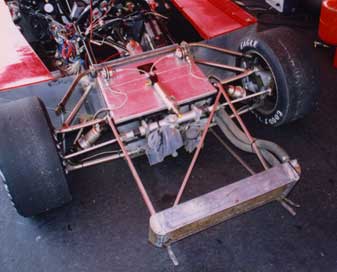
The force from this third spring translates into the hydraulic
fluid adding to the internal pressure of each of the connected
wheel dampers. The piston inside each damper has more area on
one side than the other because of the shaft. Any pressure increase
inside the damper has the effect of pushing the shaft out of
the tube increasing the ride height of the suspension. When aero
forces push the car down onto the third spring, forces increase
inside the dampers resisting and further ride height decrease.
This does not adversely affect the damping forces due to fluid
movement through shim stacks and orifices inside the dampers.
"We raced at Charlotte [North Carolina] Motor Speedway]
last summer," Ted explained. "The car produced 800
lbs. of downforce in the infield part of the track and 1,900
lbs. on the high-speed banking. Nancy had plenty of grip in the
infield and no bottoming on the banking. We used to see 1.7 or
1.8 Gs lateral acceleration and now it's 2.3 or 2.4." Ted
uses an A-Line damper dynamometer to develop his dampers.
The Engine
The 4-cylinder, 4-valve, DOHC engine is from a CBR 1000 Honda
motorcycle. This engine is highly modified from stock including
a dry-sump oil system. Ted has his own engine dynamometer and
says this engine develops 190 HP at 11,800 rpm and 92 ft-lbs.
torque at 9,200 rpm.
The gauges are analog and an add-on LCD readout displays a lap
time when triggered by a trackside beacon. A shift light warns
the driver as the engine approaches maximum rpm. Ted plans to
add a programmable flat-panel display similar to those used in
top-level systems.
A Motec engine management system provides complete control of
fuel and ignition mapping. Ted has spent considerable engineering
effort on precise placement of the fuel injection nozzles inside
an elaborate ram-air box incorporating a Lambda oxygen sensor.
"We picked up an additional 5% power with the current fuel
injector location," Ted said. "The high-pressure fuel
spray packs some extra air into the engine and there is significant
evaporative cooling. At speed the air box can give us up to a
quarter of a psi boost in inlet pressure. That's an extra 10
or 15 horsepower. I've found that the engine is happier when
it gets more air. We're running 2-inch throttle butterflies.
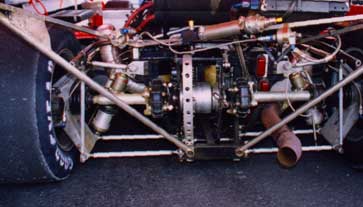
"The flexibility of the Motec system is extremely useful.
With carburetors this engine would be undrivable in the wet.
I have the option of running in closed-loop mode letting the
Lambda sensor control the fuel or open loop where I use mapping
tables for the fuel control. With the current fuel and ignition
mapping the torque curve is almost flat from 6 thou to 12 thou."
The driveline is chain drive from the transmission to an AP gear-type
limited-slip differential. The half-shafts have rubber U-joints
inboard and CV-joints outboard. A torque sensor in the right
half-shaft gives Ted a real-time measure of true engine performance.
The Motec engine management system also allows a shift-without-lift
feature allowing full-throttle upshifts in less than half the
time of a manual change. The control system activates two air
valves using high-pressure nitrogen from an on-board storage
tank to shift through the six gears. Nancy manipulates paddles
behind the steering wheel and the EMS cuts ignition to the cylinders
for a specific amount of time. During downshifts Nancy depresses
the clutch, maintains 9,000 rpm with the throttle, signals the
shifts with the paddles, and then slips the clutch as she gets
back on the throttle.
Data Acquisition
The Data Commander system has 16 channels available for data
acquisition. A trackside beacon triggers the start of each lap.
Ted uses a pitot tube to record air speed continually. "This
helps when you have a significant wind," Ted explained.
"In high-speed corners like Turn 10 at Sears Point it's
good to know the downforce available.
Among the sensors installed is a yaw-rate gyro that tells how
fast the car is turning. Ted hasn't decided if this is useful
but thinks it could be used as an indication of understeer or
oversteer. Resistor-type position sensors in the rear suspension
provide data on damper shaft velocities as well as critical ride
height measurements. "I know the spring rates at each wheel,"
Ted said, "so changes in ride height give me an indication
of movement of the aerodynamic center of pressure [CP]. The car
has a static weight distribution of 43% front, 57% rear. You'd
like the downforce to add in at the same ratio as air speed increases.
But you'd also like to dial in some understeer in high-speed
corners. I can use the rear ride height and the third spring
to control CP movement.
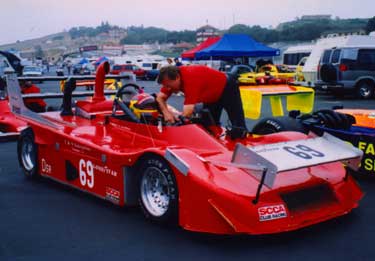
Ted has different front and rear wing configurations for high-
and low-downforce tracks. "The winglets on the nose generates
a vortex that cleans up the airflow down the side of the car,"
he explained.
Asked what computer software he uses Ted replied, "Software
Dynamation for engine simulation. With Springmaster I can look
at the spring harmonics for a given cam profile and then redesign
the cam with Cam Pro Plus. I use Billie Mitchell's [William C.
Mitchell] suspension geometry program. The data acquisition system
is made by Data Commander and I use their Track Master analysis
software as well as Bill's. For design work I use AutoCad Light."
A Typical Race Event
At the world-famous Laguna Seca Raceway near Monterey, Calif.
on a warm, sunny, July weekend 350 racecars filled the paddock
for an SCCA combined regional and national race meet. Nine DSR
racecars were entered. In addition to the cars of Lutrell Harms
and Ted and Nancy James, two Cheetah DSRs were present. The Cheetah
features an aluminum monocoque chassis built by Omni Fab and
available as a complete roller chassis for less than $25,000.
Another DSR at Laguna Seca used a Hewland Mark V gearbox mated
to a Datsun 1,300 cc pushrod, 4-cylinder engine. The owner, Travis
Duder, a multi-year national DSR champion, has a gas-powered
shifter similar to the one on the James' car. Glen Wild's Fox
DSR uses a Honda power plant and he's opted for more powerful
brakes--larger calipers and vented disks. At this event Nancy
James won the DSR class in the national race and Lutrell Harms
finished third.
Seat-of-the-Pants Engineering
It's interesting to read about the wind tunnels, exotic materials, simulation software, and teams of Ph.D. engineers needed by Formula 1 and Indy car teams, but club racers routinely perform the same tasks while having a lot more fun and chewing up much less money. The engines and tires work the same at both types of event and it's the same air flowing over the bodywork. Most importantly the races are close and exciting.
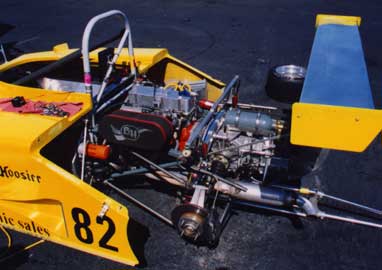
Let's hear a big cheer for the club racer!!!!